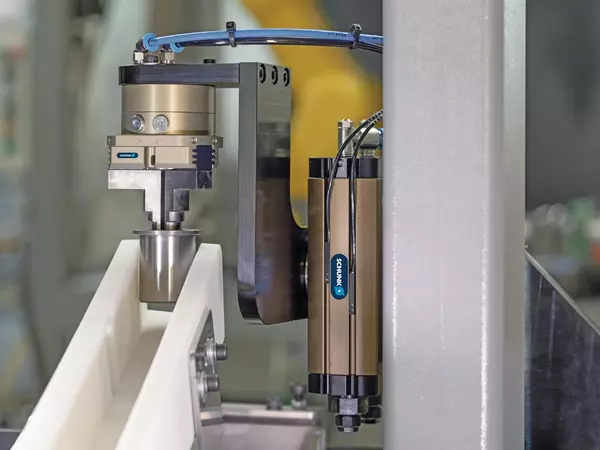


Feeding and turning, turning and discharging – in many process sequences, swivel units are required to turn and position components according to the specific application. For this purpose, SCHUNK has the robust SRM swivel unit in its portfolio, which sets standards in terms of power density, durability, commissioning and maintenance. It is now the standard for pneumatic swiveling up to 180 degrees, and impresses machine and plant builders with its combination of high torques and high mass moments of inertia with short swiveling times, large center bore, robust bearing and simultaneously slim interfering contour. The automation expert SCHUNK has now rounded off the SRM series in all the step sizes. Users can now use the size that best suits their requirements and benefit from maximum performance with compact dimensions.

In addition to various SCHUNK grippers, BFSA also installed an SRM 25 in a customer-specific automation cell. In this cell, pre-turned parts are fed individually to a knurling machine. After the knurling process, the component is removed by the robot and then cleaned by suction to remove cooling oil. The robot then guides the component over a measuring station that dynamically checks the knurling result. It is then transferred to the turning station via a PZN-plus 64 universal gripper so that it can be discharged from the cell again. At this point, the SRM swivel unit fulfills a crucial function: when the knurled component is removed from the knurling machine, it is pointing downward; for placement on the outgoing conveyor belt; it is then rotated upwards through 180 degrees by the swivel unit.
The space at this pick-and-place station is extremely tight. In terms of the cell design, BFSA focuses on compactness – as much power as possible in as little space as possible, according to the basic idea behind the cell design. For this reason, BFSA had initially installed the SRU-plus swivel module designed in-house in this tight spot, which was, however, undersized for what it had to do. Now the SRM 25 pneumatic swivel module has taken over the turning part. Since SCHUNK has currently rounded off the SRM series in all clearly graded step sizes and with a uniform torque progression, BFSA can use a smaller, lighter unit for the same application and at the same time exploit the higher performance: thanks to the greater torque of the SRM module and the high energy absorption of the shock absorbers, components are deposited precisely and gently. "This compact, robust SRM 25 swivel unit has really helped us at this tightly designed pick-and-place station," confirms Rudolf Martin, design and manufacturing manager at BFSA. "We get higher performance within the same installation space, and we can easily handle swiveling the eccentric load beyond the twelve o'clock point."
In the knurling cell, several SCHUNK grippers interact perfectly and transfer the component smoothly from one station to the next. The cell can process up to eight different component types in various sizes and geometries. Thanks to a quick jaw change system and various change sets, BFSA can flexibly change over the gripper fingers. In this way, different components can be handled in the cell with the same grippers and the same SRM 25 swivel unit.
BFSA has also used several SRM modules in a custom-designed marking cell to ensure that the process runs smoothly: first, finished turned parts are picked up by a PGN-plus-P parallel gripper on an SRM 16 swivel module after electroplating. The unit is then lifted out via a linear slide and presented to a sensor for presence monitoring. The SRM 16 module then rotates the workpiece horizontally by 180 degrees to align it correctly for the marking process. Now the robot takes over the component via the PZN-plus three-jaw gripper, guides it in front of the marking laser and then to the discharge station. Here, another parallel gripper on an SRM 16 swivel unit takes over the finished labeled component. It is turned 180 degrees, checked again by the sensor and discharged to the next processing step.

Marco Rombach
In our flexible cells, we handle very small and also relatively large parts, and one and the same automation solution must be able to cover this performance spectrum on one machine. We had designed the SRU-plus ourselves, but it was simply too small and could not provide the necessary power. But with the limited installation space, we could not install a larger unit. Then came the solution that saved the day when SCHUNK recommended the newly dimensioned SRM to us. This swivel module is now available in all step sizes, so we were able to access the size that suits us best. Despite the relatively small installation space, the SRM provides higher maximum moments and better damping, and runs with absolute stability.
The SRM has come into use throughout our company ever since then, because it enables a downward leap in size with greater power density at the same time. Since our core concept is to build compact cells that are also easy to integrate into the customer's space, installation space is always an issue for us. We always need full performance in the smallest possible space. That's why the SRM has come at just the right time for us.
Perhaps there are alternatives. But what we need is absolute reliability, and we find that with SCHUNK components. Our customers depend on reliability. Their systems run 24/7 all year round. Maximum throughput, no downtime and high flexibility are the specifications. Reliability is at the top of the list, and we don't allow ourselves any experiments here, because the customer needs the best possible delivery performance. And we can only achieve this with top quality, which is why we rely on SCHUNK.
